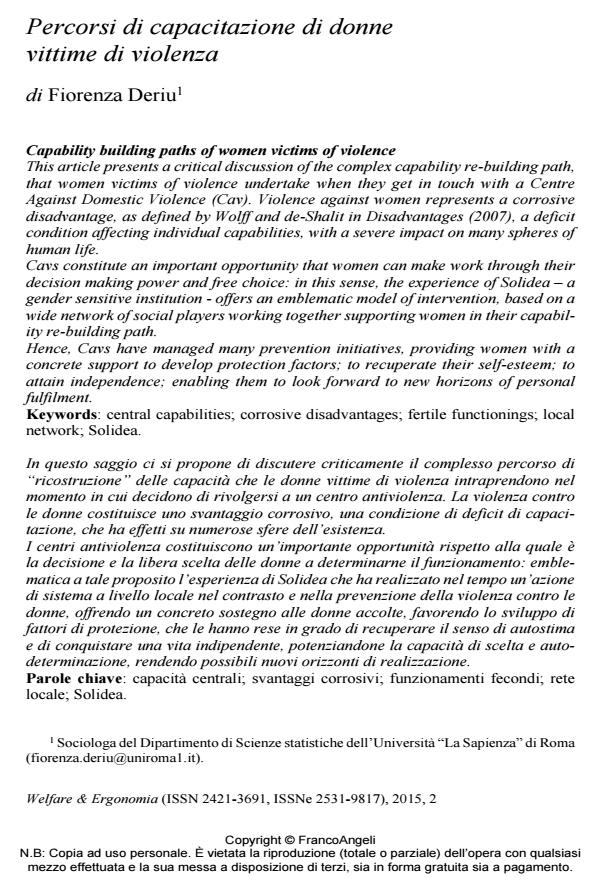Percorsi di capacitazione di donne vittime di violenza
Titolo Rivista WELFARE E ERGONOMIA
Autori/Curatori Fiorenza Deriu
Anno di pubblicazione 2017 Fascicolo 2015/2
Lingua Italiano Numero pagine 19 P. 259-277 Dimensione file 218 KB
DOI 10.3280/WE2015-002022
Il DOI è il codice a barre della proprietà intellettuale: per saperne di più
clicca qui
Qui sotto puoi vedere in anteprima la prima pagina di questo articolo.
Se questo articolo ti interessa, lo puoi acquistare (e scaricare in formato pdf) seguendo le facili indicazioni per acquistare il download credit. Acquista Download Credits per scaricare questo Articolo in formato PDF

FrancoAngeli è membro della Publishers International Linking Association, Inc (PILA)associazione indipendente e non profit per facilitare (attraverso i servizi tecnologici implementati da CrossRef.org) l’accesso degli studiosi ai contenuti digitali nelle pubblicazioni professionali e scientifiche
In questo saggio ci si propone di discutere criticamente il complesso percorso di "ricostruzione" delle capacità che le donne vittime di violenza intraprendono nel momento in cui decidono di rivolgersi a un centro antiviolenza. La violenza contro le donne costituisce uno svantaggio corrosivo, una condizione di deficit di capacitazione, che ha effetti su numerose sfere dell’esistenza. I centri antiviolenza costituiscono un’importante opportunità rispetto alla quale è la decisione e la libera scelta delle donne a determinarne il funzionamento: emblematica a tale proposito l’esperienza di Solidea che ha realizzato nel tempo un’azione di sistema a livello locale nel contrasto e nella prevenzione della violenza contro le donne, offrendo un concreto sostegno alle donne accolte, favorendo lo sviluppo di fattori di protezione, che le hanno rese in grado di recuperare il senso di autostima e di conquistare una vita indipendente, potenziandone la capacità di scelta e autodeterminazione, rendendo possibili nuovi orizzonti di realizzazione.
Parole chiave:Capacità centrali; svantaggi corrosivi; funzionamenti fecondi; rete locale; Solidea.
- Violenza domestica al tempo del Covid-19 Sara Rizzi, in WELFARE E ERGONOMIA 2/2021 pp.155
DOI: 10.3280/WE2020-002011
Fiorenza Deriu, Percorsi di capacitazione di donne vittime di violenza in "WELFARE E ERGONOMIA" 2/2015, pp 259-277, DOI: 10.3280/WE2015-002022